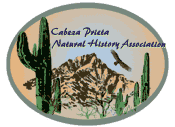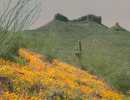
Cabeza Prieta Natural History Association
Members' Stories

Javelina
by Bill Perry
For those who live in the southwest U.S, one of the most fascinating animals that we encounter is the homely javelina. They move quietly around our neighborhoods, foraging for any food that we've carelessly left behind or put out for other animals, leaving only scat and whiffs of musky aroma as reminders of their passage. (You could never sell an air freshener in the shape of a javelina.) And whether we think they're the ugliest animals on the planet or that they are "cute," the fact remains that they are unique.
The Javelina, whose official name is "Collared Peccary," or Pecari tajacu, is a synanthrope, the label given to wild animals that are quite happy living among humans. Other synanthropes are mice, rats, coyotes, cockroaches, pigeons, raccoons and many more. The easy availability of food, plus shelter from their natural predators, are the two main reasons they prefer us over wild habitat. And, they've learned the ropes; I've seen javelinas purposely bump the pole on a bird feeder just to rain its seed onto the ground. Baby javelinas know to slip through the narrow gap between a fence and gatepost to score a meal that the adults can't reach. Note: what sets synanthropic animals apart from domesticated ones like dogs and pigs is that humans haven't intentionally bred them for some specific purpose. Normal evolution is still in effect with them and it works very well without human intervention.
Javelinas are primarily a South and Central American animal of no relation to feral pigs or wild boars, species with whom they're often confused. But they do look and act the same, all being stout, omnivorous beasts with hooves. As such, they're great examples of "convergent evolution," the process in which genetically unrelated species change over time to fit into the same environmental niche. Surprisingly, javelinas are more closely related to the hippopotamus than they are to pigs, yet the two species have developed very similar features--large heads, short legs, a tough snout and hooves--to take advantage of the scavenging omnivorous lifestyles that both have adopted.
Socially, javelinas are noteworthy. The alpha male in a herd of 5-15 performs virtually all the mating and, although lesser males can run with the group, they're not allowed near estrus females. Once born, the 1-3 babies in a litter are nursed for 2-3 months, often by their older sisters as surrogate nursemaids. Javelinas are close-knit, almost always eating and sleeping together, although larger groups may separate to forage and feed and some occasionally break off to form a new group. Unlike humans, javelinas aren't very tribal and different groups get along well with one another.
Although their eyesight is terrible, javelinas have great senses of hearing and smell. They communicate frequently with grunts and body movements as well as with strong glandular secretions. I once found myself, at night and barely clothed, in a garage full of javelinas that were raiding our rice and pasta stores--which they were able to smell from some distance. Fortunately, they panicked and ran out the door, but the stench from their brief incursion remained for days.
The javelina feature that is most debated though, isn't their smell or appearance, but how dangerous they are to us and our pets. My personal experience is fairly benign; in numerous contacts, I've never felt threatened by them and in most circumstances, as when they've invaded a yard, they herd easily. I do avoid getting too close to mothers with babies, knowing they'll defend them readily. On the other hand, I've read accounts of javelinas attacking dogs, especially ones alone on a leash, so it's best to avoid that situation.
But the question remains: Are javelinas cute? Like humans, old gnarly ones may not be that attractive, but the kids, mincing along on tiny legs behind their mommies, qualify as "totally cute."
Copyright Creative Commons
HTML & Programing by
Thomas R. Powell